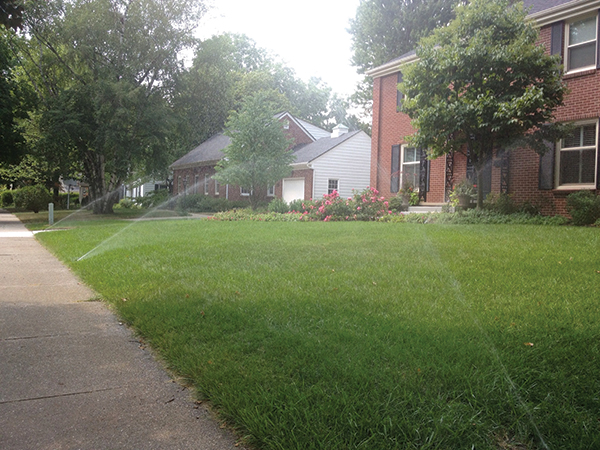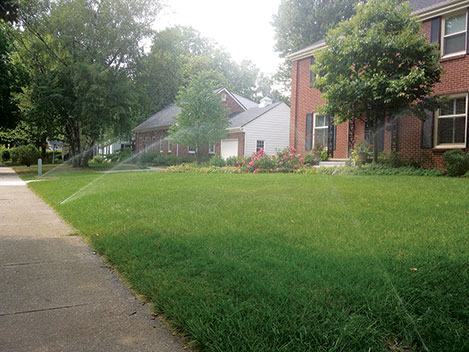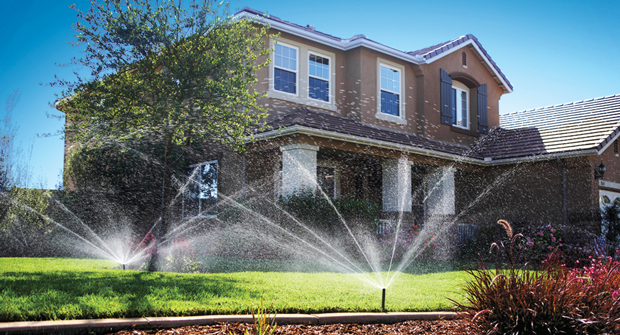
mobile app connectivity. photo: WINCHEL IRRIGATION
With today’s advances in water tech, irrigators see the benefits in efficiency and affordability.
U.S. water rates are rising, water restrictions are becoming the norm, and technology is more affordable than ever before. Together, these facts are driving trends in irrigation controllers, setting the stage for more efficient, affordable and compliant watering on residential and commercial landscapes across the country.
“The cost of technology is dropping rapidly, so this whole confluence of events puts us in a position where it’s going to affect irrigation and the irrigation controller more than any other category in the water management business,” says Mike Mason, president and CEO of Weathermatic, a Garland, Texas-based manufacturer of smart irrigation products.
So much in irrigation control has changed in the last several years—perhaps attitudes toward water use most of all. During the construction boom of 1997 to 2007, builders tended to install cheap or common irrigation systems, without considering water restrictions, water cost or any other water-related concern, Mason says.
That changed with the rising water rates and restrictions of the last three years, and now, he says, “It’s on an absolute tear. The old idea of whatever’s the cheapest, no concern for the local water restrictions, is gone. Now builders are paying more attention to installing a good irrigation system.”
For commercial properties
The result for commercial businesses is new and improved central control systems, Mason observes. Where these controllers once cost about $10,000 to $15,000 each, people now can buy them for less than $1,000 each, he says.
Today’s central control systems no longer require a dedicated computer or server, either. “Now your smart controller can be operated from any device that can connect to the Internet via the cloud,” Mason says. “Because of this radical drop in price and improvement in simplicity, everybody’s going to manage their water.”
Cloud computing makes it easier for large companies with several office locations to comply with local water restrictions, too, say Mason and Chris Spain, founder of HydroPoint Data Systems, a maker of smart water management products headquartered in Petaluma, Calif.
“A host of regulations have come out, such as you can’t irrigate from 10 a.m. till 4 p.m.,” says Spain. “It gets very complicated, and having that data put into a cloud is a huge advantage. Our customers are able to see which sites are in compliance and which aren’t through cloud computing.”
Spain says irrigation managers also can expect to see an increase in the use of on-site flow sensors soon if they haven’t already, particularly in regions subject to water restrictions. Until now, commercial landscapes haven’t used flow sensors much because they’ve been too expensive to install, he says.
“But we’ve come up with affordable installation of flow sensors,” Spain says. “And that will be the big trend this year. There will be more flow sensors across all verticals of the industry.”
Among them are high-resolution flow meters that work well even on low-flow sites; and flow sensor/master valve combinations that make for easier installation. Such solutions will empower commercial irrigation professionals on the job now and in the years to come, giving them real-time tools for identifying excessive water use and waste, Spain says.
High-resolution flow meters can be especially useful, he says, allowing irrigation professionals to spot small leaks or potential leaks that before would have been missed. Flow sensing systems are capable of texting or emailing commercial irrigators on-site to alert them to overwatering or a mainline break.
Greg Winchel, owner of Grand Rapids, Mich.-based Winchel Irrigation, where 60 percent of the clientele is residential and 40 percent is commercial, says the company has been using smart controllers almost exclusively for four years. But smart controllers are hardly new. So if there’s a trend Winchel has observed in irrigation controllers from a user standpoint, it’s that manufacturers continue to improve them.
“The manufacturers are learning more about these timers and how to make them more efficient than what they were in the beginning,” says Winchel, whose company uses Rain Bird ESP-SMT controllers. “The general idea of the timer hasn’t changed, but I have noticed advances in the firmware and programming each year.”
In short, Winchel says, irrigators can be more specific with their settings for soil conditions, precipitation rate and
application rate. “With all those factors in there, and an on-site weather pod collecting temperature and rainfall amounts, it’s more informed and can do a better job of irrigating,” Winchel says.
For homeowners
John Wascher, product manager, residential controllers, for Hunter Industries in San Marcos, Calif., says the percentage of equipment in the field with “smart” capabilities is still quite small. Nonetheless, he’s seeing municipalities install smart water meters on residential properties to better enforce water restrictions.
“It helps people quantify how much water they’re using, detect water waste, notify the controller and have it send a message to someone,” Wascher says. “We’re going to see that 2015 will be full of water restrictions.”
Wascher also sees a trend toward more water connectivity at home. “Everybody’s racing to get something that’s connected,” he says, referring to controllers that are cloud-based, Wi-Fi- connected and controllable with a mobile app. “But the big challenge right now is (determining) what’s going to be the standard protocol. In the last two years, I haven’t seen anyone emerging as the leader or a specific technology that everyone will migrate to. Until we come up with a little more of an industry standard, everybody’s going on their own.”
Examples of these products include controllers from Skydrop, Rachio and other startups. And while many homeowners are familiar with such applications for things around the home, such as thermostats and locks, they’re often surprised to learn there are also “easy-to-use, residential smart controllers that also offer self-adjusting and cloud-based programmability features,” says Eric Santos, vice president of irrigation services for Brickman/ValleyCrest Cos., based in Calabasas, Calif.
“What makes these smart controllers different is that they communicate to the cloud through the home’s Wi-Fi signal, as opposed to using a built-in cell modem,” he says. They also don’t require an annual subscription fee, he says.
“As the general public becomes more and more aware of the features and ease of use of home automation products—including irrigation timers—devices that can operate off of a home’s Wi-Fi signal without reoccurring service fees will continue to gain market share,” Santos says.
Wi-Fi controllers average $225 now, but as competition drives down costs or water districts offer rebates, homeowners could eventually pay less than $100 for them, Santos says. “The possibility of large manufacturers developing Wi-Fi-based smart controllers also could drive a decrease in the price point of these residential products,” he says.
In the next few years, consumers can expect to see more advancements with wireless and/or battery technology, Wascher adds.
It’s no surprise, Mason says. “This is what people want—they want technology, they want simplicity, they want to be able to manage their water.”
Geraci is a freelance writer based in Cleveland.


